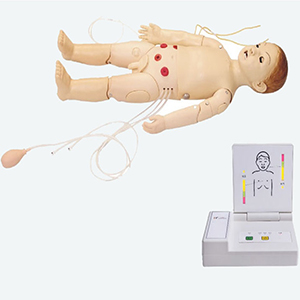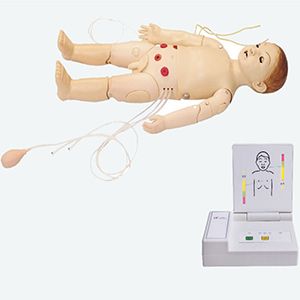In pediatric emergency care, in the face of children with unstable vital signs and rapidly changing conditions, medical staff need to have the ability to react quickly and precise operation skills. Especially for infants and toddlers under the age of one, their physiological characteristics are very different from adults and children, and improper handling can lead to serious consequences. For this reason, advanced human simulation technology came into being, especially for simulating the first-aid scene of one-year-old children, which has become an effective tool to train medical personnel's first-aid skills.
Optimizing first aid skills: the unique advantages of simulation training

Advanced Simulator for one-year-old Children
1. Real situation simulation
The one-year-old advanced simulator can accurately simulate the physiological characteristics of one-year-old children, including heartbeat, breathing, body temperature, etc., which is crucial to improve the response ability of medical staff in actual first aid. Through this highly reductive training environment, students can practice various first aid operations in risk-free conditions and familiarize themselves with possible emergencies in advance.
2. Quick response and decision-making ability
In pediatric emergency care, time is often of the essence. The one-year-old advanced simulator can simulate a variety of first aid scenarios, such as sudden asthma, asphyxia, cardiac arrest, etc., to help medical staff train repeatedly in the simulation and improve their response speed and decision-making accuracy in first aid. The data showed that health care workers trained with simulators responded about 25 percent faster to emergency situations.
3. Improvement of skill proficiency
Through simulated human training, medical personnel can repeatedly practice a variety of first aid skills, such as airway management, cardiopulmonary resuscitation (CPR), and drug infusion. According to one study, participants trained with simulators experienced a 30% increase in the success rate in actual first aid operations and a significant reduction in the incidence of errors.
Data support: The effect of simulated training
According to multiple studies on medical simulation training, medical personnel using advanced simulators for pediatric emergency training have shown significant improvement. Here are a few key data sets:
- Improved response time: First aid response time was reduced from 15 minutes to an average of 12 minutes after the simulation training.
- Operation accuracy: Trainees improved their operation accuracy by 27% in simulated first aid scenarios.
- Increased clinical confidence: More than 80% of participants said they were more confident when faced with real first aid scenarios after simulated training.
Clinical significance: improve first aid response and processing ability
First aid training through advanced simulators of one-year-old children can not only help medical staff master the correct first aid skills, but also enhance their clinical decision-making ability in the face of real situations. Emergency work often requires medical personnel to make quick judgments, and trained students can remain calm and efficient in emergency situations. This will not only help improve the success rate of emergency care, but also lead to long-term improvements in the quality of care.
conclusion
The one-year-old advanced simulator is undoubtedly an important tool for improving pediatric first aid skills. By simulating different first aid scenarios, medical staff can gain experience in a risk-free environment and improve emergency response capabilities, operational accuracy and clinical confidence. With the continuous development of technology, simulation training will become a routine part of medical education to further optimize the training of first aid skills and ensure the safety of patients.

